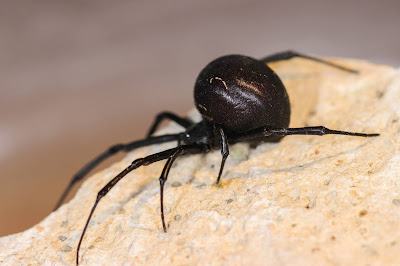
 The Mediterranean black widow (Latrodectus tredecimguttatus), also known as the European black widow, or steppe spider, is a species of widow spiders in the genus Latrodectus. It is commonly found throughout the Mediterranean region, ranging from Portugal to southwest and central Asia, hence the name. Specimens from central Asia are also known by the binomial name Latrodectus lugubris; that name, however, is considered obsolete, though it is still commonly found in the literature. Latrodectus tredecimguttatus used to be considered a Latrodectus mactans subspecies.
The Mediterranean black widow (Latrodectus tredecimguttatus), also known as the European black widow, or steppe spider, is a species of widow spiders in the genus Latrodectus. It is commonly found throughout the Mediterranean region, ranging from Portugal to southwest and central Asia, hence the name. Specimens from central Asia are also known by the binomial name Latrodectus lugubris; that name, however, is considered obsolete, though it is still commonly found in the literature. Latrodectus tredecimguttatus used to be considered a Latrodectus mactans subspecies.
 L. tredecimguttatus is black in color, similar to most other widow species, and is identified by the thirteen spots which are found on its dorsal abdomen (the species name is Latin for "with thirteen spots"). These spots are usually red in colour, but may also be yellow or orange. It is otherwise similar to other species in the genus Latrodectus. The Mediterranean widow primarily lives in steppes and other grasslands, and can be a significant problem in areas where grain is harvested by hand. The female of the species has a body length of about 7–15 mm (0.28–0.59 in), while the male is smaller and reaches 4–7 mm (0.16–0.28 in) at best. Only the female spider's bite is dangerous (either for humans or cattle) as the male cannot penetrate the relatively thick epidermis.
L. tredecimguttatus is black in color, similar to most other widow species, and is identified by the thirteen spots which are found on its dorsal abdomen (the species name is Latin for "with thirteen spots"). These spots are usually red in colour, but may also be yellow or orange. It is otherwise similar to other species in the genus Latrodectus. The Mediterranean widow primarily lives in steppes and other grasslands, and can be a significant problem in areas where grain is harvested by hand. The female of the species has a body length of about 7–15 mm (0.28–0.59 in), while the male is smaller and reaches 4–7 mm (0.16–0.28 in) at best. Only the female spider's bite is dangerous (either for humans or cattle) as the male cannot penetrate the relatively thick epidermis. Like all Latrodectus species, L. tredecimguttatus has a painful bite that is fatal in rare cases. They are not in close association with humans generally, and epidemics of bites have been reported There are many reports of Ukrainian farm workers receiving bites while working in the fields. The LD-50 of L. tredecimguttatus venom has been measured as 0.59 mg/kg,[4] and separately again as 0.59 mg/kg (with a confidence interval of 0.33–1.06).
Like all Latrodectus species, L. tredecimguttatus has a painful bite that is fatal in rare cases. They are not in close association with humans generally, and epidemics of bites have been reported There are many reports of Ukrainian farm workers receiving bites while working in the fields. The LD-50 of L. tredecimguttatus venom has been measured as 0.59 mg/kg,[4] and separately again as 0.59 mg/kg (with a confidence interval of 0.33–1.06).
In Kazakhstan, there are reports of this species biting and killing camels.
From Wikipedia, the free encyclopedia
Photos Nicosia,Athalassa 5/11/2014 by George Konstantinou
 |
| Female |
















No comments:
Post a Comment